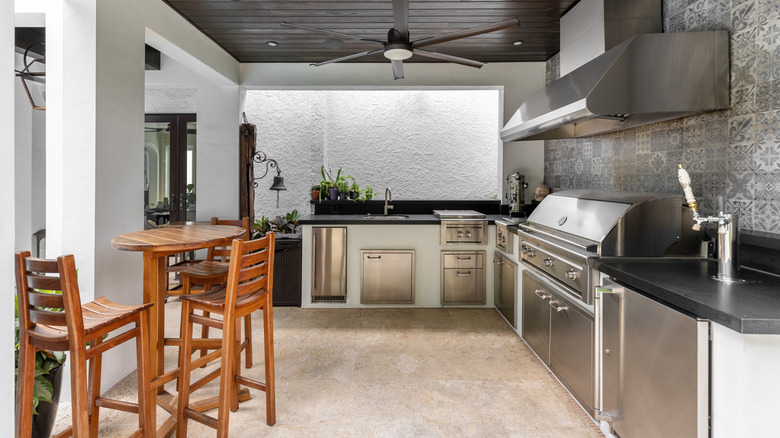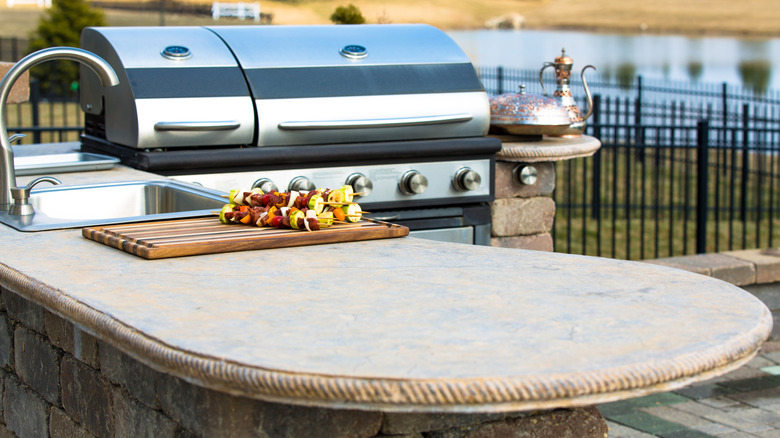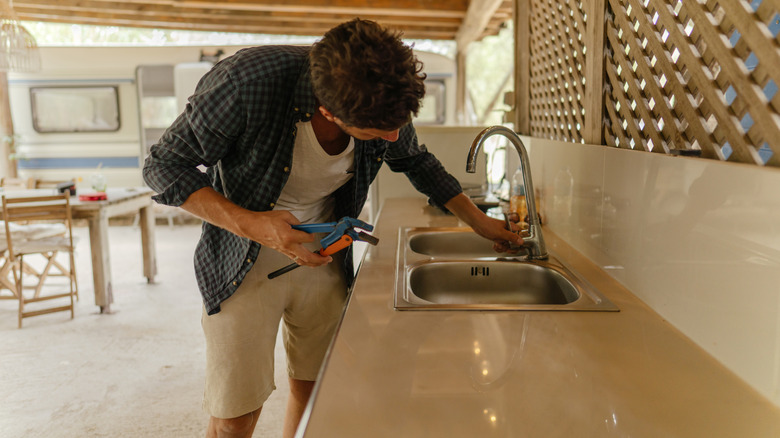Downsides To Building An Outdoor Kitchen You'll Wish You Knew Before Starting
Just like cats, there are two types of people: outdoor and indoor. And for outdoor types, anything that allows you to spend more time in fresh air and sunshine is a good thing. Outdoor kitchens are becoming increasingly popular for that reason, and you don't necessarily have to own a luxury property to add a kitchen to your outdoor living space. However, there are downsides to consider, including the high expense, extensive maintenance requirements, and significant use of outdoor space.
Outdoor kitchens typically include some of the same amenities as an indoor kitchen, like a fridge, sink, and stovetop. But they may also have special amenities for outdoor entertaining, such as a grilling station, pizza oven, icemaker, or bar area. Since the flooring, cabinetry, and appliances all need to withstand year-round weather, outdoor kitchens require more careful planning and maintenance than indoor ones, which adds up to a higher cost. The investment also includes the process of extending out any utilities that are necessary for the kitchen to be functional, like water and electricity. This cost may not be worth it for everyone, given the other potential downsides.
Outdoor kitchens take up space
After all is said and done, building an outdoor kitchen can cost $275 to $900 per square foot, plus another $1500 to $7000 for appliances. Most outdoor kitchens are between 100 and 400 square feet total. While you can DIY some parts to save money, hiring an experienced and trustworthy professional is the best way to guarantee that the kitchen lasts for years to come.
On one hand, an outdoor kitchen can extend your home's living space and make the yard more usable. But if your yard isn't very big to begin with, it may not be the most practical idea, since it will take up a significant footprint that can no longer be used for other activities. It's also important to check manufacturing guidelines since some appliances need to be a certain distance away from your home to be safe. HOA regulations could also determine how close you can build an outdoor kitchen to your house or your neighbors' homes and what elements you can include.
Before building an outdoor kitchen, consider how often you'll be able to actually use it. Do you live in a place with comfortable year-round weather? If not, that footprint may be better used for something else. In freezing temperatures, outdoor kitchens need to be winterized to prevent burst pipes or other issues. That includes shutting off utility lines, unplugging and emptying the fridge, and covering everything up.
Outdoor kitchens need regular maintenance
Weather protection is important for outdoor kitchens outside of the winter, too. While they can last over a decade, they won't make it that far if not properly installed and maintained. Left to the elements, materials can rot, rust, or corrode. Even salty air or frequent rain can quicken wear and tear. A covering of some sort is ideal to protect from rain or snow, and rust-resistant materials such as stainless steel are key. But even stainless steel needs to be regularly cleaned with a non-abrasive, mild cleaner to prevent issues from weather and use.
Other maintenance steps are important as well. Gas lines should be checked regularly for safety, and grills need to be deep-cleaned yearly. Before storms, you'll need to cover up the furniture and grill to protect them from moisture. Yard work can leave debris and stains, so you'll need to practice caution and sweep the kitchen clean after you mow.
It can also be harder to keep an outdoor kitchen clean than an indoor one because of all the dust, rain, bugs, and so on. Outdoor countertop materials need to be wiped down regularly, and if they're porous (like granite), they must be re-sealed every few years to prevent stains. If you don't stay on top of cleaning after each time you use the kitchen, pests could become a frequent issue.


